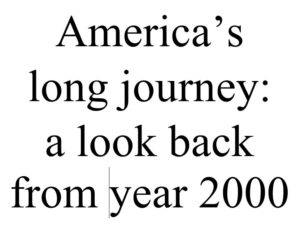
All through the nineteenth century runs a continual, taken-for-granted background. Behind politics, and economics, and international affairs, and commerce, and the fine and useful arts, and industry and agriculture and everything else, there was this underground river, running quietly from east to west, transforming everything in its path.
The river was a river of internal immigration. People in New England upped stakes and moved to New York state, or Pennsylvania. People in the middle colonies, and people on the Atlantic seaboard of the old South moved across the Appalachians, or around them. The new nation’s boundaries extended to the Mississippi, and after the Louisiana Purchase extended to the distant Rockies, and after John Quincy Adams’ treaty extended to the Pacific Ocean. Could such vast expanses ever be populated by the new civilization?
Yes, it could.
The government of the Articles of Confederation had enacted Jefferson’s ideas in the Northwest Ordinance of 1787, as we shall see. Instead of the original thirteen colonies holding land in common as a perpetual colony, that common land would be subdivided, and organized politically, and formed into states fully equal to the original thirteen. (The fact that it requires an effort for us to realize that things might have been different shows how thoroughly accepted this radical idea became.) Thus there was no political disadvantage to moving to a new territory.
No political disadvantage, and a tremendous economic advantage. America was desperately short of labor. Growing up with a new country, a man could make a good life for himself and his family. As Abraham Lincoln said, from his own experience, the paid laborer of today could become the independent laborer of tomorrow, and the employer of labor after that. Those conditions didn’t last forever, but they certainly lasted a good half-century, up to the onset of the Civil War.
And as people left the older states, their places were filled by continual and increasingly numerous immigration from the Old World, particularly after the War of 1812. What opportunity could hidebound, tightly controlled England and Scotland and Ireland offer a poor individual, compared to America? And what were the barriers? They already spoke the language. They were familiar with the political forms and the cultural background. They fit right in.
And then it wasn’t long before the various unhappy countries of Europe were providing waves of immigrants. They came, they did whatever work they found, they learned the language and absorbed the opportunities, and after a while – a few years, a couple of decades, maybe a generation – these immigrants or their children tended to move west as well, following economic opportunity, and their places in the older states were filled by new arrivals.
It was a vast, impersonal quiet kneading of peoples into one new people. No longer could the country be adequately described as New England, South, Middle Colonies. Yes, people tended to move west in more or less the same lines of latitude they were accustomed to, but the streams acted as streams do when they flow together. First there were eddies, then swirls, then mixture at the edges, and finally a new stream, larger than its constituent elements and no longer divisible. Behind the scenes, not directed by anybody, the republic was reshaping itself.